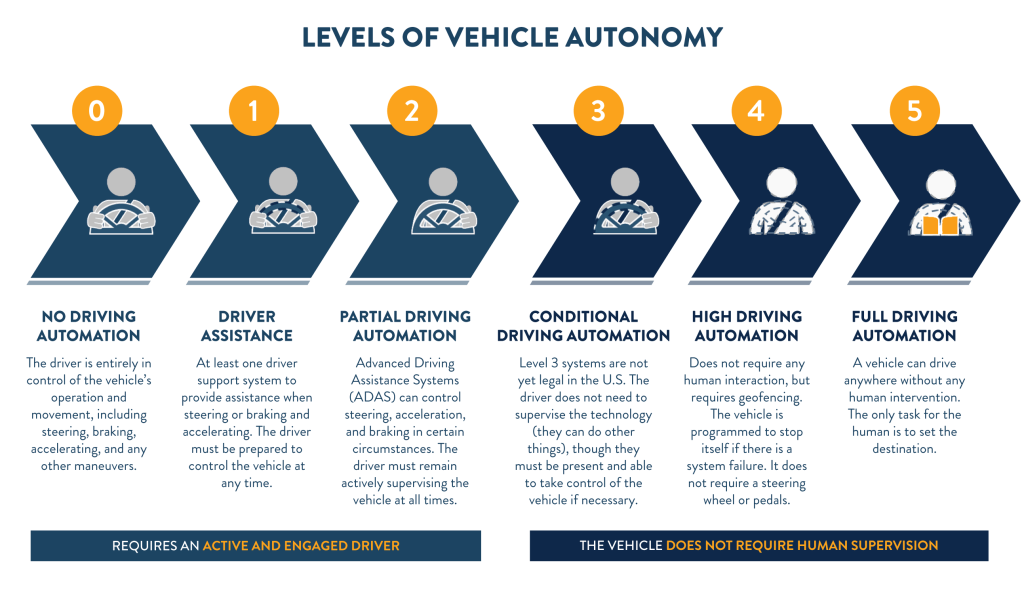
The 6 levels of autonomous driving explained
Does increased vehicle autonomy equal safer roads?
A self-driving car is a vehicle that has the capability to sense what’s happening around it and move through its environment safely with little or no human intervention.
The inspiration for this technology started as early as the 1920s, and trials were conducted in the 1950s. Automated vehicle research and development was undertaken in earnest in the U.S. in the 1980s.
Technology for self-driving vehicles has been developing rapidly in recent years, and so have concerns about their safety. The Society of Automotive Engineers (SAE) published 6 levels of autonomy that self-driving cars must achieve before they can safely travel on roadways. The U.S. Department of Transportation has adopted those standards.
So far, the development of technology for vehicle autonomy has not yet reached the highest level foreseen by the SAE.
Benefits to self-driving vehicles
Automation technology is promoted as an enhancement of vehicle safety. The government reports that as many as 95 percent of car accidents are attributable to driver error. Greater autonomy purportedly offsets the risks of driver behavior such as alcohol or drug-impaired driving, speeding and distraction.
Additional potential benefits include:
-
- Increased self-sufficiency for people with disabilities like blindness or paralysis
-
- Lower insurance premiums due to fewer crashes
-
- Less road congestion due to fewer crashes
- Increased worker productivity if drivers can work while commuting
SAE’s 6 levels of vehicle autonomy
The Society of Automotive Engineers has been around almost as long as the automobile. Its principal mission is to set standards for automotive technology. Standardization is essential for uniformity and safety.
In 2014, the SAE published basic standards for automated vehicles. It established 6 classifications defined by the amount of driver intervention and personal attention required by the system. Eventually, the National Highway Traffic Safety Administration (NHTSA) adopted SAE’s classification as its own, and it became widely accepted globally.
Below are the 6 levels of autonomy (or amount of driver assistance) needed to operate a vehicle as defined by the SAE.

Level 0 (No automation)
A level 0 vehicle is 100% manually controlled. Most cars today are Level 0 vehicles. There may be some systems that help the driver, such as an emergency braking mechanism. However, it does not drive the vehicle, so it doesn’t qualify as a self-driving component.
Level 1 (Some driver assistance)
This lowest level of automation includes just 1 automated system, such as steering or cruise control. Adaptive cruise control can maintain a safe speed under the circumstances and keep the vehicle at a safe distance behind other vehicles. This level requires human control of other aspects like steering and braking.
Level 2 (Partial automation)
With advanced driver assistance systems (ADAS), your car can control both steering and speed. The driver must remain in the driver’s seat and be ready to take over the controls at any time.
A few cars commercially available today qualify as Level 2.
Level 3 (Conditional driving automation)
Level 3 is significantly more technologically advanced than Level 2. Level 3 vehicles can detect environmental conditions and make decisions about safe responses. For example, the system can accelerate past a slow-moving vehicle. However, the driver must remain vigilant and override the system when necessary.
At this time, there are no Level 3 vehicles available in the U.S.
Level 4 (High driving automation)
The major advancement of a Level 4 system is that the driver does not need to intervene in most cases. However, a human driver can still manually override the system.
Level 4 vehicles can operate in a self-driving mode only in limited urban areas where legal speed limits don’t exceed 30 mph.
There are no Level 4 vehicles available to average consumers. However, Arizona is experimenting with Level 4 vehicles in a taxi service. So far, they have exceeded 10 million miles.
Level 5 (Full driving automation)
Level 5 cars will be fully automated with autonomous controls. They will not require a driver, a steering wheel, manual acceleration or braking controls. While they’re being tested in many countries, no Level 5 vehicles are available anywhere to the general public.
In summary, there are currently no vehicles higher than Level 2 available for drivers in the U.S. and probably won’t be for several years. This is not because of existing technology shortfalls but rather safety concerns.
Accident statistics for self-driving cars
The NHTSA has issued a standing order requiring vehicle and equipment manufacturers and operators of Level 2 vehicles to report crashes to their agency.
Currently, 108 manufacturers are subject to the NHTSA reporting requirements. They’re required to report any crash involving a Level 2 system that results in an injury requiring hospitalization, a fatality, a vehicle needing to be towed, or an airbag deployment.
The NHTSA has reported that crashes of semi-autonomous cars have resulted in multiple fatalities and serious injuries, and they expect the number to grow. In fact, for the 10 months ending in May 2022, there were 392 crashes reported. Of those reported accidents, 98 included injury reports, of which 11 were serious injuries, and 5 were fatal.
Contact a California car accident attorney
While consumers are increasingly looking forward to self-driving vehicles, proven technology is several years off. Also, the NHTSA is becoming more concerned about the safety of the technology.
If you’re injured in an accident involving a Level 2 vehicle, there may be special considerations for a claim, and more than 1 party may be at fault. You should contact an experienced car accident lawyer for guidance.
At MVP Accident Attorneys, our experienced personal injury attorneys will investigate your case and prove liability to get you maximum compensation. Our firm has recovered millions of dollars for our clients across California and Texas, and we'd love to help you too.
Contact us today for your free, no-obligation consultation. There’s never a fee unless we win your case.
Author

Brett Sachs
Brett S. Sachs graduated from Michigan State University College of Law with Cum Laude Honors. While attending Michigan State, Brett was awarded for his service in the Michigan State University College of Law Civil Rights Clinic, where he represented prisoners of the Michigan Department of Corrections from injustices brought upon them. Learn more.
Top-Rated Lawyers

Lizbhett Rodriguez
Jason Acosta

When You’ve Been Injured
Personal Injury Law

